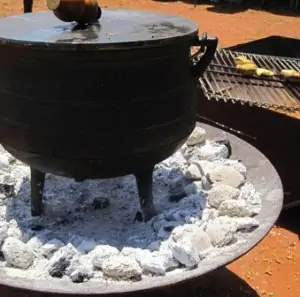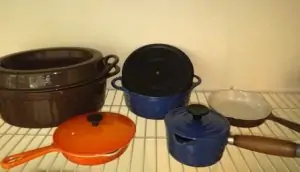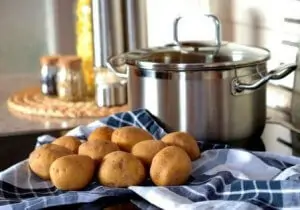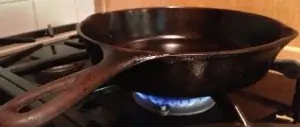
We’ve all heard the phrase, “if you can’t stand the heat, get out of the kitchen,” right? High heat cooking produces some of the most delicious and flavorful dishes you can imagine, so it’s a great technique for your cooking repertoire. So what’s the best type of cookware to use when cooking with high heat?
Generally, when people say “high heat cooking,” they’re referring to techniques like stir-frying, sauteing, and searing meats.
Cooking ingredients at high temperatures evaporate their natural moisture, which allows the nutrients and proteins to form into a savory natural browned crust.
But cooking at high heats can actually be dangerous if you don’t have the right materials for the job. Make sure your cookware can handle the heat of your kitchen by checking it against the list below.
| Best Cookware for High Heat Cooking | Picture | Material |
|---|---|---|
| 1. Lodge LCC3 Cast Iron Combo Cooker |  | cast iron |
| 2. Lodge Carbon Steel Skillet |  | carbon steel |
| 3. Le Creuset Enameled Cast Iron Skillet |  | enameled cast iron |
| 4. Cuisinart Stainless Steel Skillet |  | stainless steel |
Cast Iron
Cast iron is a go-to in most kitchens. This is due to its incredible capacity for heat retention, and its multi-functionality. It’s safe for use on a stovetop, grill, oven, or even directly over the open fire.
Needless to say, this is definitely a material that’s a safe bet for high heat cooking. It’s also relatively inexpensive and very durable.
Although it is heavy and takes some maintenance it needs to be seasoned with a thin coat of oil after each use.
It’s a perfect material to look for in your cookware if you’re looking to try high heat cooking.
Lodge LCC3 Cast Iron Combo Cooker
Carbon Steel
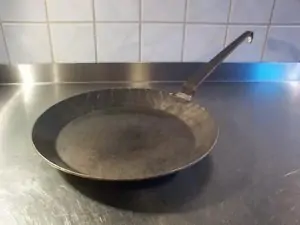
Carbon Steel is a great mid-range compromise to stainless steel and cast iron.
It’s lighter than cast iron and slightly heavier than stainless steel, aluminum, or copper.
It offers many of the same high heat benefits as cast iron with great heat conductivity.
And also requires seasoning just as cast iron does. This can contribute to some truly flavorful meals, however.
Try carbon steel if you’re looking for a middle ground between the conductivity of cast iron and insulation of the stainless steel.
Lodge Carbon Steel Skillet
Enameled Cast Iron
Enameled cast iron takes the previous material one step further by taking out the need for seasoning.
This cookware is a cast iron base with a ceramic enamel cooking surface.
This provides added superior heat conductivity and even cooking, which is a fairly common complaint from regular cast iron cookers.
The only downside of the enameled cast iron is that it doesn’t have the natural non-stick abilities of cast iron since it doesn’t need seasoning.
It’s also more expensive than regular cast iron. But if you’re looking for an even distribution of high heat every time, enameled cast iron is the way to go.
Le Creuset Enameled Cast Iron Skillet
Stainless Steel Combinations
Stainless steel is another common high heat cooking material.
It also tends to be more aesthetically pleasing according to cooks.
It’s very durable and easy to clean – usually dishwasher safe.
But in terms of heat conductivity, especially high heat, it’s not the best on its own.
That’s why a lot of high heat cookware combines stainless steel with another material for maximum usage. This usually includes copper or aluminum.
On their own, each of these materials isn’t great for high heat cooking. Copper and aluminum conduct heat very quickly, making it easy to burn or overcook, and stainless steel tends to be too slow or have too much insulation for thorough cooking.
The insulation of the stainless steel along with the heat capacity of other lighter materials makes these combination cookwares perfect for even, safe high heat cooking.
It also evens out the price, as copper/aluminum cookware tends to be much more expensive than stainless steel.
Cuisinart Stainless Steel Skillet
Do you like whipping up a healthy stir fry? Here are my recommendations for the best carbon steel woks.
Avoid Non-Stick Surfaces
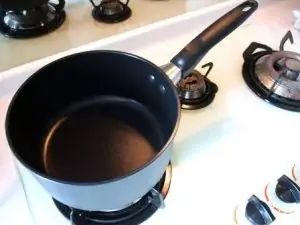
If you only have non-stick pans in your kitchen, you’ll need a new set if you’re thinking about trying high heat cooking.
At high temperatures, the artificial non-stick coating can actually melt or break down.
Toxic residues from this breakdown process can mix with your food and contaminate it, causing it to be dangerous for consumption.
Avoid Teflon and other products advertised as non-stick (except for natural non-stick surfaces, like you may get with the seasoning process) for the safety of your food.
If you stick to the materials outlined above for your high heat cookware and avoid non-stick surfaces, you’ll be stir-frying, sauteing, and searing in no time.
High heat cooking produces delicious results, so get yourself some safe high heat cooking materials and turn up the heat!
Frequently Asked Questions
Are non-stick pans designed for high heat cooking?
Not really. The surface of non-stick pans can create fumes which have been shown to be unhealthy. The breakdown process creates toxic residues that often end up in food, causing it to be harmful for human consumption. While more difficult to clean, cast iron and stainless steel cookware circumvent the worry of accidentally ingesting flaking surface. Also, over time Teflon will flake off — It goes somewhere and often it’s in your food.
Why is copper coated on the bottom of cookware?
Copper is a perfect heat conductor. It spreads heat evenly and dispenses it accordingly. Copper saves energy considerably and the risk of scorching is minimal.
What type of materials can withstand the highest temperatures?
Both stainless steel and cast iron pans should be good to 1500 degrees Fahrenheit, but the former can hold out to 2200 degrees Fahrenheit. Copper melts at around 1900 F while aluminum melts at 1200 F. That said, your best options for high heat cooking are cast iron and stainless steel. Carbon steel is a good alternative to stainless steel and cast iron.
What is the difference between cladding and coating?
Cladding refers to layers of metal fused together to create cookware. A stainless steel pan may actually have an aluminum or copper inner layer. Cladding may also mean that a material was added to the bottom of a pan to enhance heat transfer. Otherwise known as hard-coat anodized, coating refers to changing the soft surface of an aluminum pan to a hard one. This is not related to non-stick coating.
Why do some professional chefs prefer carbon steel pans?
Carbon steel is extremely efficient and specially designed for high heat cooking. It is suitable for any cooktop, highly durable and wipes clean easily. The main downside is that it has to be seasoned to prevent rust and corrosion. It’s also not safe for dishwashing.
